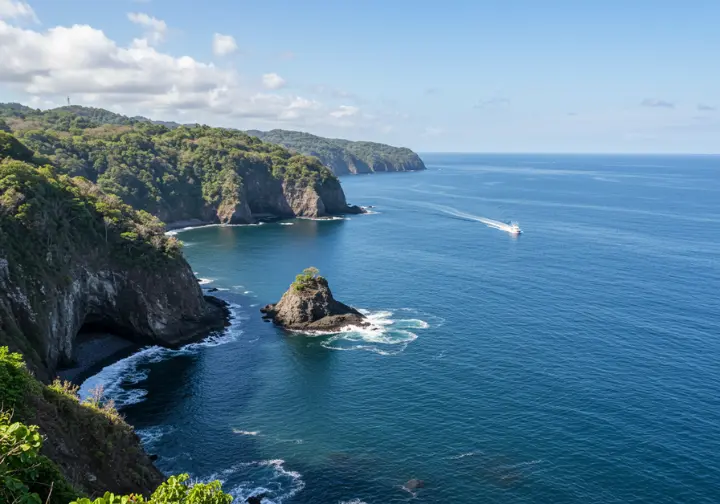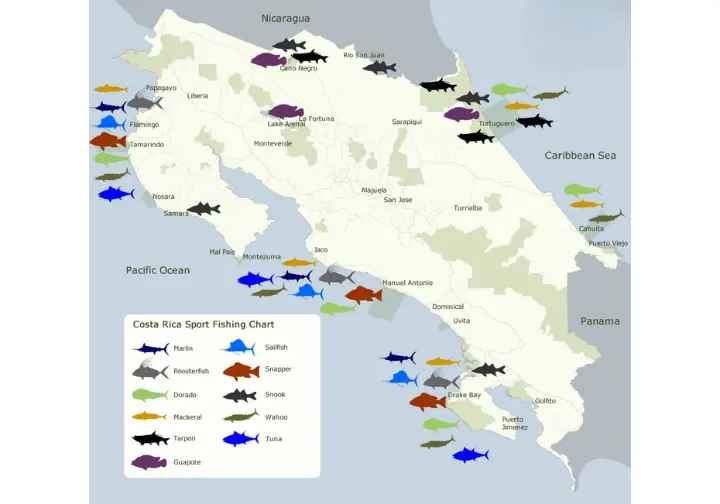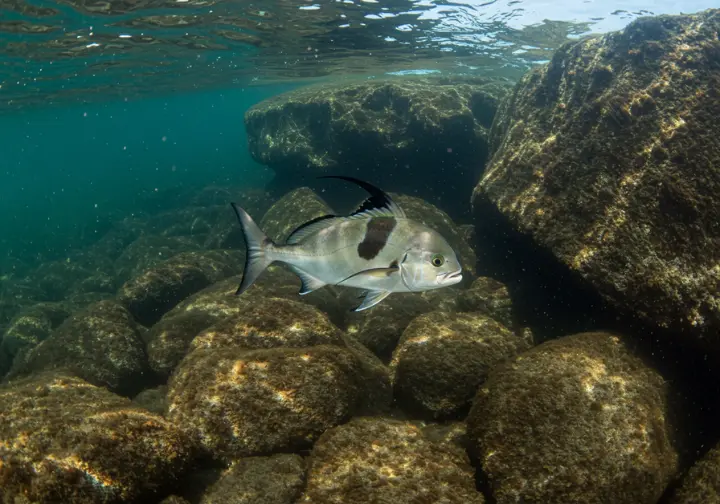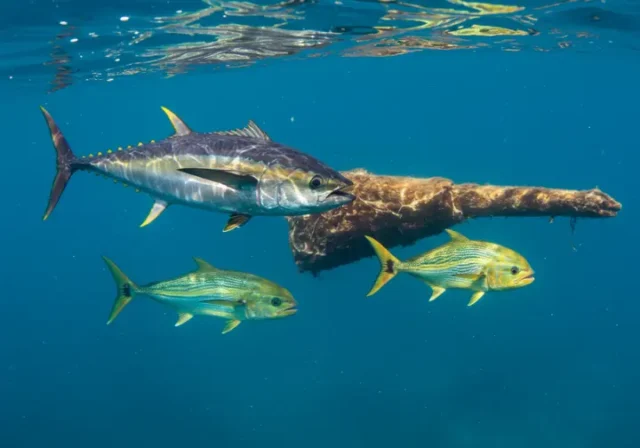In this article
In Costa Rica, the fishing goes way beyond billfish! Hit the Pacific during the green season (May to November) for tuna and dorado—peak moments in Costa Rica fishing seasons. The Caribbean delivers tarpon, snook, and dorado all year, while roosterfish and snapper keep rods bending no matter the month. Follow baitfish patterns for an edge on the water. Secure your INCOPESCA license before you go—it’s essential. Practice catch and release, especially with billfish, to protect the ecosystem. Learn from seasoned local captains; the fishing secrets here are endless.
Pacific Coast Fishing Opportunities

You’ll find Pacific Coast fishing changes quite a bit depending on where you are, so it’s important to learn the hot spots. We’re going to unpack how Costa Rica’s dry and green seasons affect your fishing experience. We will investigate how these environmental alterations influence the fishing! The Golfo Dulce region offers incredible biodiversity with over 50 species catchable from kayaks during peak seasons.
Understanding Coast Variations
Costa Rica’s pacific coast is a hotbed for angling adventures, but knowing its regions can make or break your trip. You’ve got the North (Guanacaste), Central (Los Sueños, Quepos), and South (Osa Peninsula, Golfito), each with its unique costa rica fishing seasons. Recall, it’s not just about billfish peak seasons; many other species are around year-round.
Understanding the differences between the pacific coast and caribbean coast is key. The Pacific boasts great offshore fishing and inshore fishing. Tuna and dorado offshore, or roosterfish and snapper closer to shore. Don’t forget local weather seasons play a huge role too. Peak billfish season runs from December to April, making it prime time for marlin fishing.

Local guides know best, so tap into that knowledge for the best fishing destinations. Your fishing calendar shouldn’t be without that vital intel!
Dry vs Green Seasons
Since Costa Rica dances to the rhythm of distinct seasons, anglers should know because the dry season (December to April) and green season (May to November) dramatically change fishing on the Pacific side. You’ll find calmer seas and clearer waters during the dry season, perfect for billfish. Conversely, the green season, notwithstanding afternoon showers, ignites costa rica fishing with boosted baitfish populations.
It’s the signal which kicks off incredible seasonal runs! The green season draws big yellowfin tuna and dorado. River mouths? Hotspots for snook and roosterfish. Grasping these weather seasons is key. Ocean temps vary, affecting everything. El Niño/La Niña? They can really shake things up. So research, plan, and get ready for unforgettable costa rica fishing on the pacific ocean, not the caribbean! During peak months, Los Sueños offers world-class sailfish action with double-digit catches possible.
Tuna and Dorado Seasons

You’ll find yellowfin tuna fishing peaks aren’t uniform across Costa Rica’s coastal regions. Insight into when and where dorado season changes can boost your chances. Let’s look closely at these variations and help you plan your next trip. Tuna follow baitfish movements closely, so tracking sardine or mackerel schools can lead you to hotspots.
Yellowfin Tuna Regional Peaks
When chasing yellowfin tuna in Costa Rica, knowing the regional hotspots and seasonal peaks is key to maximizing your chances of hooking into these energetic fish. Central Pacific waters offer year-round fishing opportunities, with larger hauls from June-September. In the Southern Pacific region, you’ll find bigger trophy yellowfin tuna during May-November.
Guanacaste holds some variability. You’ll discover how excellent tuna fishing from December-April, but too May-September requires checking local fishing reports for current peaks. Locating these schools involves finding spinner dolphins, birds, and bait fish. You’ve got various tactics. You can try anything from live baiting to trolling, making yellowfin tuna fishing an exciting pursuit.
Anglers seeking consistent action will encounter smaller tuna year-round. For those targeting billfish peak season, the Pacific coast delivers prime opportunities from late November to April.
Dorado Season Variations
Dorado, furthermore known as Mahi-Mahi, are year-round residents along Costa Rica‘s Pacific coast, guaranteeing a splash of color and acrobatic battles on nearly any offshore trip you’re planning. You’ll find that as present all year, dorado fishing enjoys peak fishing season during the rainy season, May to November in costa rica. The preceding is attributed to the annual dorado migration following the baitfish return.
For larger “bull” dorado, September and October are your golden months. Bear in mind, success varies in different popular fishing spots. The Catalinas Islands and Gulf of Papagayo are prime spots. Keep in mind coastal regions such as Los Suenos and Jaco have produced January-April and May-June, indicating the seasonal winds impact.
You could as well experience offshore fishing on the Caribbean coast too. Rising tides often bring more dorado closer to shore during peak feeding times.
Pacific Inshore Species Calendar

You’re probably wondering when’s the best time to target those inshore beasts. Let’s break down the Pacific side’s key players and their peak seasons so you can plan your trip. We’ll be covering snapper hot spots throughout the year, roosterfish prime times, and helpful insights concerning grouper and mackerel.
Snapper Year-Round Patterns
Snapper fishing in Costa Rica isn’t just a season; it’s a year-round opportunity to test your skills against some tough fighters along the Pacific coast. With great inshore fishing opportunities, different snapper species, including the popular red snapper, are available for anglers seeking action. Costa Rica’s regional trends affect your success.
You’ll find greater productivity in Guanacaste during the wet season. Nevertheless, the dry seasons may be better along the northern Pacific coast. For trophy cubera snapper, head toward the southern pacific coast between February and April.
Bottom fishing’s a frequent method. You’ll want to jig near reefs. From January to July, you’ll find typically increased snapper activity. Choose fishing techniques based on the snapper you’re after. For the best results, match the hatch by using bait that mimics local mullet or sardines, similar to techniques used for Roosterfish in Cabo San Lucas.
Roosterfish Prime Times
If you’re looking for a prized inshore gamefish, then roosterfish are active year-round along the Pacific coast, thanks to their unique dorsal fin and vigorous fight. Roosterfish are a popular game fish; you’ll find ’em year-round, these sport fish are a blast. But, the peak roosterfish season often hits during the dry months (December-April).
That’s when the water’s clearest, making sight fishing a killer fishing method.
Don’t think fishing trips are only good then; from May to early November, especially near river mouths, can be epic. For example, the coast’s North Pacific islands offer great fishing October through March. Look for rocky spots and rivers, and recall, releasing roosterfish guarantees there’ll be another one for you or your friends. Although not in Nica, Costa Rica offers plenty of opportunities to find what you need.
Grouper and Mackerel Insights
Grouper and mackerel offer exciting year-round fishing opportunities in Costa Rica, but you’ll find seasonal patterns impact your success. You can target various grouper, a prized fish species, all year using bottom fishing tactics. The dry season normally presents calmer seas for fishing boats. The Pacific side, particularly Los Sueños/Jaco Beach, may see grouper peaks January-April and July-August.
Mackerel, a fun coastal fish, are abundant. Warmer temperatures, typical of the dry season, should increase their activity in the pacific. Trolling small lures is effective; or you can try casting into the feeding fish. You’ll find mackerel along the Costa Rica coasts, making them accessible. You’ll see how grouper and mackerel provide consistent action throughout the year.
Caribbean Coast Fishing Highlights

Aren’t non–billfish species your target when fishing Costa Rica’s Caribbean side? You’ll find how certain times of year provide ideal chances for specific catches. Now, we’ll cover the best periods to hook your desired Caribbean species.
Targeting Non-Billfish Species
As the Caribbean coast is known for tarpon and snook, you’ll find several other species which can make your trip even more exciting, as you discover the region’s diverse fishing scene. The caribbean offers year-round fishing opportunities. Dorado are available, too.
Tuna inhabit the Caribbean sea with tuna season during several windows. Even though, not the primary target, they might show up further offshore. You’ll find mackerel on costa rica’s caribbean shores. These popular sport fish offer consistent inshore action. They’re a reliable fallback.
Target wahoo from February to June. They’re fast pelagic fish, so high-speed trolling works. These are great targets beyond billfish. Grasping these targets enhances your experience.
Key Caribbean Fishing Periods
Though tarpon and snook might top many anglers’ lists, comprehension of the key Caribbean fishing periods helps you plan for diverse opportunities beyond these mainstays. You’ll find year-round fishing potential on the caribbean side of costa rica, but weather impacts conditions.
Spot the main tarpon seasons which usually peaks August to January. Furthermore the fishing regulations. Wahoo fishing shines February to June. We are aware this is often drier weather. Dolphin, or dorado, are around all year, adding fun offshore. Recollect, local insights beat generalities; August fishing conditions vary.
When you plan, ask about dorado, tuna and wahoo. Don’t only depend on the main tarpon seasons. Be sure to research the caribbean side weather, it affects the fishing, so plan on the right periods and you will not be disappointed. Matching lure and bait is crucial for maximizing success during these key fishing periods.
Expert Tips and Regulations

You’ll improve your Costa Rican angling experience when tapping into some expert advice. You’ve got to understand the rules to fish responsibly here. Let’s look at ways you can protect these waters for awesome catches in the future. Prioritize responsible angling with barbless hooks to minimize harm to fish populations.
Leveraging Local Knowledge
To really nail your Costa Rican fishing trip, you’ve got to tap into the gold mine of knowledge held by local experts. These aren’t your average fishermen; they’re intimately connected to the water. They know where to find the good fishing.
You’ll find priceless insights from rican charter boat captains around the marina or through fishing lodges. Don’t just assume the peak billfish season is the only time to go. Local guides constantly adjust based on weather and bait movement to attract bait fish.
Different marinas and fishing lodges specialize, so find one suited to your sport fishing goals. Talk things over before your trip. Their knowledge goes way beyond a calendar. They understand those subtle cues which signal when certain species are most active and know how to promote responsible fishing. This is how you score!
Navigating Fishing Rules
Maneuvering Costa Rica’s fishing rules is key if you want to keep your lines tight and avoid trouble with the local authorities. First, a valid sport fishing license from INCOPESCA is a must-have. You can often buy them online, so don’t skip this step!
Knowing the costa rican fisheries regulations is critical. Regulations protect marine ecosystems. Pay attention to protected zones where fishing is off-limits; charters steer clear of those areas for good reason. Gill netting and net fishing rules exist.
Also, be aware of the specific regulations for each species, and bear in mind billfish are strictly catch-and-release. Recent initiatives aim to move commercial purse seine operations further offshore to benefit us too. Keeping up with those costa rica regulations helps maintain a healthy fishery for everyone.
Conservation Best Practices
When you’re deep sea fishing, use circle hooks, especially important during international fishing tournaments, they minimize harm, boosting survival rates. Handle fish carefully, be quick with photos (less than 60 seconds out of water), and wet your hands first. Support rican boats and charters prioritizing sustainable practices.
Don’t litter, don’t damage reefs. By respecting these guidelines, you guarantee the waters teem with life for years to come.
Final Fishing Recommendations
For a memorable fishing experience, always consult local experts before you go. They’ll have vital intel about current conditions. Remember to check INCOPESCA regulations, including licenses and catch limits. That info is key for planning half-day fishing trips out of puerto towns. By practicing conservation, you’re ensuring tourism in costa rica remains sustainable for years to come with thriving fish populations. Proper planning guarantees an unforgettable experience.
Popular Questions
What Tackle/Gear Rentals Can I Find Near My Location? +
Are There Family-Friendly Fishing Charters Available? +
What Is the Typical Cost of a Fishing License? +
What’s the Best Way to Prevent Sea Sickness? +
Are There Any Fishing Tournaments I Can Join? +
We are a participant in the Amazon Services LLC Associates Program, an affiliate advertising program designed to provide a means for sites to earn advertising fees by advertising and linking to Amazon.com. As an Amazon Associate I earn from qualifying purchases. We also participate in other affiliate programs. The information provided on this website is provided for entertainment purposes only. We make no representations or warranties of any kind, expressed or implied, about the completeness, accuracy, adequacy, legality, usefulness, reliability, suitability, or availability of the information, or about anything else. Any reliance you place on the information is therefore strictly at your own risk. Additional terms are found in the terms of service.




![Ultimate Cabo Fishing Guide: Charters & Tips [2025] Iconic Cabo San Lucas arch at sunrise with a sportfishing boat nearby, representing the ultimate fishing guide destination.](https://masterfishingmag.com/wp-content/uploads/2025/05/01-ultimate-cabo-fishing-guide-2025-238x178.webp)




